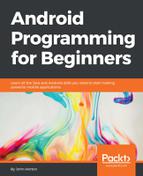- Android Programming for Beginners
- Table of Contents
- Android Programming for Beginners
- Credits
- About the Author
- About the Reviewers
- www.PacktPub.com
- Preface
- 1. The First App
- 2. Java – First Contact
- 3. Exploring Android Studio
- 4. Designing Layouts
- 5. Real-World Layouts
- 6. The Life and Times of an Android App
- 7. Coding in Java Part 1 – Variables, Decisions, and Loops
- 8. Coding in Java Part 2 – Methods
- 9. Object-Oriented Programming
- Important memory management warning
- Introducing OOP
- Taking a look at the code for a class
- The basic classes mini app
- Remember that encapsulation thing?
- Encapsulation and static methods mini app
- OOP and inheritance
- The inheritance mini app
- Polymorphism
- FAQ
- Summary
- 10. Everything's a Class
- 11. Widget Mania
- 12. Having a Dialogue with the User
- 13. Handling and Displaying Arrays of Data
- 14. Handling and Displaying Notes in Note To Self
- 15. Android Intent and Persistence
- 16. UI Animations
- 17. Sound FX and Supporting Different Versions of Android
- 18. Design Patterns, Fragments, and the Real World
- Introducing the model-view-controller pattern
- The imperfections of Note To Self revisited
- Android design guidelines
- Real-world apps
- The device detection mini app
- Configuration qualifiers
- Using configuration qualifiers – mini app
- Fragments
- Our first working Fragment mini app
- Fragment reality check
- FAQ
- Summary
- 19. Using Multiple Fragments
- Using singletons for the model layer
- Inter-Fragment communications – interfaces revisited
- The dual-Fragment address book mini app
- Getting started
- Alias resources
- The NameAndAddress class
- Creating the communication interface
- Explaining the structure of the onListItemSelected method
- Explaining the code that starts a new Activity
- Explaining the code when the detail Fragment is already present
- What do we need to do?
- Creating the AddressDetailFragment class and layout
- Coding PortraitDetailActivity and the layout
- FAQ
- Summary
- 20. Paging and Swiping
- 21. Navigation Drawer and Where It's Snap
- 22. Capturing Images
- 23. Using SQLite Databases in Our Apps
- 24. Adding a Database to Where It's Snap
- 25. Integrating Google Maps and GPS Locations
- 26. Upgrading SQLite – Adding Locations and Maps
- 27. Going Local – Hola!
- 28. Threads, Touches, Drawing, and a Simple Game
- 29. Publishing Apps
- 30. Before You Go
- Index
So, what does this Fragment stuff really do for us? Our first Fragment mini app would have exactly the same appearance and functionality had we not bothered with Fragment at all. In fact, using Fragment has made the whole thing more complicated! Why would we want to do this?
We kind of know the answer to this already, but it just isn't especially clear based on what we have seen so far. We know that Fragment or fragments can be added to the layout of an Activity. We know that a Fragment not only contains its own layout (view), but also its very own code (controller), which although hosted by Activity, the Fragment is virtually independent.
Our quick mini app only showed one Fragment in action, but we could have an Activity that hosts two or more fragments. We can then effectively have two almost-independent controllers displayed on a single screen. This sounds like it could be useful.
What is most useful about this, however, is that when the Activity starts, we can detect attributes of the device that our app is running on, perhaps a phone or tablet or in the portrait or landscape orientation. We can then use this information to decide to display either just one or two of our fragments simultaneously.
This not only helps us achieve the kind of functionality discussed in the Real-world apps section at the start of the chapter, but it also allows us to do so using the exact same Fragment code for both possible scenarios! This really is the essence of fragments. We can create a complete app by pairing up both functionality (controller) and appearance (view) into a bunch of fragments that we can reuse in different ways, almost without care.
It is, of course, possible to foresee a few stumbling blocks, so take a look at these FAQs.
-
No Comment
